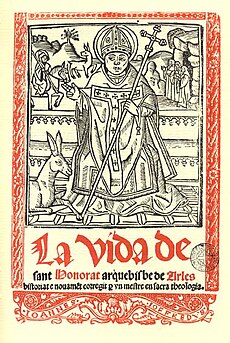From Fr Alban Butler's Lives of the Saints
HE was of a consular Roman family, then settled in Gaul, and was well versed in the liberal arts. In his youth he renounced the worship of idols, and gained his elder brother Venantius to Christ, whom he also inspired with a contempt of the world. They desired to renounce it entirely, but a fond Pagan father put continual obstacles in their way: at length they took with them St. Caprais, a holy hermit, for their director, and sailed from Marseilles to Greece, with the design to live there unknown, in some desert. Venantius soon died happily at Methone; and Honoratus, being also sick, was obliged to return with his conductor. He first led an eremitical life in the mountains near Frejus. Two small islands lie in the sea near that coast: one larger, at a nearer distance from the continent, called Lero, now St. Margaret’s; the other smaller and more remote, two leagues from Antibes, named Lerins, at present St. Honoré, from our saint, where he settled; and being followed by others, he there founded the famous monastery of Lerins, about the year 400. Some he appointed to live in community; others, who seemed more perfect, in separate cells, as anchorets. His rule was chiefly borrowed from that of St. Pachomius. Nothing can he more amiable than the description St. Hilary has given of the excellent virtues of this company of saints, especially of the charity, concord, humility, compunction, and devotion which reigned amongst them, under the conduct of our holy abbot. He was by compulsion consecrated archbishop of Arles in 426, and died exhausted with austerities and apostolical labours in 429. The style of his letters was clear and affecting: they were penned with an admirable delicacy, elegance, and sweetness, as St. Hilary assures. The loss of all these precious monuments is much regretted. His tomb is shown empty under the high altar of the church which bears his name at Arles; his body having been translated to Lerins in 1391, where the greater part remains. See his panegyric by his disciple, kinsman and successor, St. Hilary of Arles; one of the most finished pieces extant of this kind. Don Rivet, Hist. Lit. t. 2. p. 156. 1
HE was of a consular Roman family, then settled in Gaul, and was well versed in the liberal arts. In his youth he renounced the worship of idols, and gained his elder brother Venantius to Christ, whom he also inspired with a contempt of the world. They desired to renounce it entirely, but a fond Pagan father put continual obstacles in their way: at length they took with them St. Caprais, a holy hermit, for their director, and sailed from Marseilles to Greece, with the design to live there unknown, in some desert. Venantius soon died happily at Methone; and Honoratus, being also sick, was obliged to return with his conductor. He first led an eremitical life in the mountains near Frejus. Two small islands lie in the sea near that coast: one larger, at a nearer distance from the continent, called Lero, now St. Margaret’s; the other smaller and more remote, two leagues from Antibes, named Lerins, at present St. Honoré, from our saint, where he settled; and being followed by others, he there founded the famous monastery of Lerins, about the year 400. Some he appointed to live in community; others, who seemed more perfect, in separate cells, as anchorets. His rule was chiefly borrowed from that of St. Pachomius. Nothing can he more amiable than the description St. Hilary has given of the excellent virtues of this company of saints, especially of the charity, concord, humility, compunction, and devotion which reigned amongst them, under the conduct of our holy abbot. He was by compulsion consecrated archbishop of Arles in 426, and died exhausted with austerities and apostolical labours in 429. The style of his letters was clear and affecting: they were penned with an admirable delicacy, elegance, and sweetness, as St. Hilary assures. The loss of all these precious monuments is much regretted. His tomb is shown empty under the high altar of the church which bears his name at Arles; his body having been translated to Lerins in 1391, where the greater part remains. See his panegyric by his disciple, kinsman and successor, St. Hilary of Arles; one of the most finished pieces extant of this kind. Don Rivet, Hist. Lit. t. 2. p. 156. 1

No comments:
Post a Comment
Comments are subject to deletion if they are not germane. I have no problem with a bit of colourful language, but blasphemy or depraved profanity will not be allowed. Attacks on the Catholic Faith will not be tolerated. Comments will be deleted that are republican (Yanks! Note the lower case 'r'!), attacks on the legitimacy of Pope Francis as the Vicar of Christ (I know he's a material heretic and a Protector of Perverts, and I definitely want him gone yesterday! However, he is Pope, and I pray for him every day.), the legitimacy of the House of Windsor or of the claims of the Elder Line of the House of France, or attacks on the legitimacy of any of the currently ruling Houses of Europe.